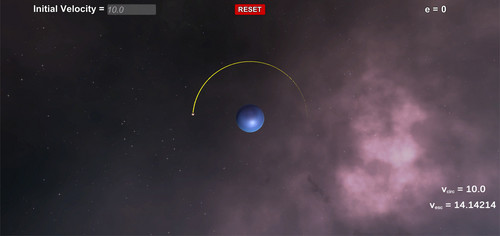Now with data!

To aid in the discussion of orbital mechanics and orbital energies, I've included several additional fields listing various orbital energy and geometry parameters.
Orbital Energy
All orbital energies are calculated as specific (per unit mass) energies in the fictitious units of the simulation; let's call them pfargls (pf). In these units and for a circular orbit, the specific kinetic energy is +50 pf and the specific potential energy is -100 pf yielding a total energy of -50 pf. When a non-circular orbit is modeled, one can see the interplay between kinetic and potential energy with the kinetic energy increasing toward periapsis and decreasing toward apoapsis while the potential energy exhibits the opposite trend. The total energy should remain reasonably constant.
- KE = (1/2) v^2
- PE = - G M / r
- E_tot = KE + PE
Orbital Geometry
One of the fundamental characteristics of an orbit or trajectory is its eccentricity. In order to calculate the eccentricity, we need a variety of energy and momentum parameters:
where epsilon is the total specific energy as shown above, h is the specific angular momentum (h = |r x v|), and mu is the standard gravitational parameter, mu = G M.
Once we have the eccentricity, we can calculate the periapsis (nearest distance) and the apoapsis (farthest distance). In the fictitious units of the simulation, the velocity for a circular orbit is 10. If the initial velocity is set to less than this, then the initial distance of 20 will be the apoaspsis and the periapsis is calculated. If the initial velocity is set to greater than 10, then the initial distance will be the periapsis and the apoapsis is calculated.
- apoapsis = periapsis * (1 + e) / (1 - e)
- periapsis = apoapsis * (1 - e) / (1 + e)
Now one can demonstrate that circular orbits have eccentricities of zero and the KE = -(1/2) PE, that all closed (elliptical) orbits have negative total energies, that parabolic trajectories have zero total energy, and that hyperbolic trajectories have positive total energies. You can find out more about these calculations at https://en.wikipedia.org/wiki/Orbital_eccentricity.
Files
Get Planetary Motion Demo
Planetary Motion Demo
A simulation and demonstration of Kepler's Three Laws of Planetary Motion.
| Status | Released |
| Author | J. Douglas Patterson |
| Genre | Educational |
| Tags | astronomy, demonstration, keplers-laws, orbital-motion, Physics, Tutorial |
More posts
- Volume ControlDec 22, 2022
- Functionality UpgradesNov 19, 2020
- Upgrading the UIJul 15, 2020
- New UI With Physical UnitsOct 14, 2019
- Kepler's 2nd Law FeatureSep 08, 2019
- Added Camera MotionSep 02, 2019


Leave a comment
Log in with itch.io to leave a comment.